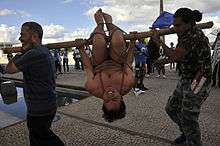Pau de Arara
Pau de Arara is a Portuguese term that literally translates to "macaw's perch". The term originates from the habit of tying birds to a pole for sale, where they also hang for transportation. By analogy, the term has gained two distinct meanings: it can refer to an irregular flat bed truck used to transport migrant workers and to a torture device developed during the Brazilian military dictatorship.
Flat bed truck

Pau de Arara is a designation given in the Northeast Brazil to a flat bed truck adapted for passenger transportation. The truck's bed is equipped with narrow wooden benches and a canvas canopy. The term refers to long metal rails extending lengthwise under the canopy where passengers would hang on to when standing.
This form of public transportation is still found in rural areas, but no longer available for interstate travel. In past decades, it was widely used by migrant workers fleeing periodic drought conditions in their home region. In the states of São Paulo and Rio de Janeiro, their most frequent destination, Pau de Arara also became a derogatory slang term referring to them. There are frequent references to the Pau de Arara in Brazilian literature and popular song, used as a symbol for the plight of the Nordestino (Northeastern) migrant.
Torture technique

Pau de Arara can also refer to a physical torture technique designed to cause severe joint and muscle pain, as well as headaches and psychological trauma. The technique consists of a tube, bar or pole placed over the victim's biceps and behind the knees while tying the victim's both ankles and wrists together. The entire assembly is suspended between two metal platforms forming what looks like a bird's perch.
This technique is believed to originate from Portuguese slave traders, which used Pau de Arara as a form of punishment for disobedient slaves. Its usage has been more recently widespread by the agents of the political police of the Brazilian military dictatorship against political dissidents in the 1960s and 1970s and is still believed to be in use by Brazilian police forces,[1] although outlawed.[2] The device was often used as a restraint for a combination of other torture techniques, such as water boarding, extraction of nails from the toes and fingers, branding, electric shocks, and sexual torture.
References
- Box, Ben; Jane Eggington; Mick Day (2003). Brazil Handbook. Footprint Travel Guides. ISBN 1-903471-44-3.
- MacCann, Bryan (2004). Hello Brazil: Popular Music in the Making of Modern Brazil. Duke University Press. ISBN 0-8223-3273-6.